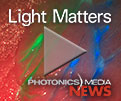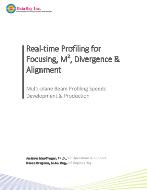


|
Live-Cell Imaging Evolves to Find New Niches
Both bright-field and fluorescence techniques can capture cellular processes for observation of real-time dynamics. Since its introduction in the 1600s, improvements in microscope technology have continually broadened the types of cells and cellular processes that can be studied. Advances in automation have made this already-simple tool faster and more capable, and time-lapse imaging reveals function and dynamics in addition to structure. Live-cell imaging has enabled us to witness incredible moments in biology in unprecedented detail. Even embryogenesis – the process of cell division and cellular differentiation that occurs at the earliest stages of life – has recently been captured.
|
|
|
|

Moving Past the Articulated Arm
Fiber lasers ofeer surgical applications more versatility and flexibility, and easier integration into medical instruments. Surgery requires a deft hand and a fluid touch. And yet, for some time, the most common method of delivery of surgical lasers was the use of mechanical articulated arms. Many clinicians were reluctant to use the lasers because they felt they were too heavy or cumbersome, and that they restricted their movement in the operating theater.
|
|
|
|

Q&A: Adaptive Optics 'On the Rise'
Three company representatives touch on the variables driving the market for adaptive optics for biological applications. Adaptive optics started off looking out to the sky, helping astronomers correct for distortions caused by the Earth’s atmosphere – but the technology has since found additional applications of a more inward nature: in biology, where it helps researchers correct for the distortions they encounter as they send light into tissue. To take the pulse of the bio market for adaptive optics, BioPhotonics spoke with: Michael Feinberg, director of sales and marketing at Boston Micromachines Corp. in Boston; James Joubert, applications scientist at Photometrics in Tucson, Ariz.; and Christian Theriault, president and CEO of Tag Optics Inc. in Princeton, N.J.
|
|
|
|

The Recent History of Endoscope Design: Way More Than Candlelight and Specula
The history of endoscopy is the history of advances in technology leading doctors deeper into the gastrointestinal tract and providing clearer views of what they find there. And the past several years have seen tremendous strides in endoscope design, offering greater access to the GI tract, higher sensitivity and an ability to probe areas that are often inaccessible to conventional systems.
|
|
|
|


|
sponsored by

|
In this edition of the industry's premier weekly newscast: an array pushes solar deep into buildings, a special camera detects tumors, and a fiber optic switch is controlled by a single atom. Hosted by Photonics Media's Laura Marshall and Melinda Rose.
|
|
|

Sculpted Light Captures Brain Activity
A high-speed imaging technique that “sculpts” the 3-D distribution of light in a sample can resolve a single neuron in a living worm, opening possibilities for studying the function of the organism’s nervous system and pairing brain function to anatomy. A major aim of neuroscience today is to understand how an organism’s nervous system processes sensory input and generates behavior by observing the activity of cells across the entire brain. But to do this, scientists need detailed maps of how the nerve cells are wired in the brain as well as information on how these networks interact in real time.
|
|
|
|

Laser-Based Tool Tells Normal Tissue From Tumors
A new laser tool can microscopically distinguish between normal and cancerous brain tissue in real time. It doesn’t miss cells that could trigger new tumor growth, so it could make brain cancer surgery much more effective. The approach, called SRS (stimulated Raman scattering) microscopy, was developed and tested by a multidisciplinary team of chemists, neurosurgeons, pathologists and others affiliated with the University of Michigan Medical School and Harvard University.
|
|
|
|

Spaghettilike Surface Makes Stronger SERS Sensor
Spaghettilike arrays of gold-coated metallic carbon nanotubes can amplify the signals of surface-enhanced Raman spectroscopy (SERS) enough to allow the performance of analyses that are more reliable, sensitive and cost-effective. Potential applications include real-time point-of-care monitoring of physiological levels, fast screening of drugs and toxins in law enforcement, and early detection of biological weapons.
|
|
|
|



|
iFLEX-iRIS Lasers
Qioptiq
Qioptiq is proud to present the new iFLEX-iRIS™ series of miniaturized high performance laser systems, designed for integration into precision instrumentation.
More info >>
|
|
 |

|
157 Series Optical
Thickness Gauge
Bristol Instruments, Inc.
Bristol Instruments has introduced the 157 Series optical thickness gauge for manufacturers whose development and production processes require precise thickness information about materials such as specialty plastic films, medical membranes and ophthalmic products.
More info >>
|
|
 |
|
|
 |
|
 |


|
Real-time Profiling for Focusing, M2, Divergence & Alignment
DataRay Inc.
Beam intensity profiling is an essential tool in many aspects of photonics. The precise intensity distribution in a focused laser beam is critical in many applications: flow cytometry, laser printing, medical lasers, and cutting lasers are just a few examples. Intensity profile measurements can characterize and improve a product or process, leading to substantial cost and time savings that can pay for the measurement instrument many times over. This white paper describes how the unique, patented, real-time multiple z-plane XYZTF capabilities of the BeamMap2 slit-scan profiler can speed and simplify laser assembly alignment.
DOWNLOAD WHITE PAPER >>
|




|
EPIC, the industry association promoting the sustainable development of organizations working in photonics in Europe, will hold the workshop "Unmet Healthcare Needs as Opportunities for Technologies" Nov. 27 and 28 in Maastricht, Netherlands. The conference is divided into four sessions. Session 1, "Setting the Scene - Introductory Presentations," will include discussions on the technology and business landscape, developing new ways to fund biophotonics devices, and the regulatory environment for medical devices. Session 2 covers “Electronics & Optics for Point-of-Care Devices for Chronic and Infectious Diseases,” while Session 3 encompasses “Photonics Components for Medical Imaging & Microscopy” and Session 4 pertains to “Unmet Health Care Needs as opportunities for Photonics Technologies."
MORE INFO >>
|
|

|

|


Follow Photonics Media on Facebook and Twitter
|
 

|
|

sponsor
 |

sponsor
 |

sponsor
 |

sponsor
 |

sponsor
 |

sponsor
 |

sponsor
 |


|